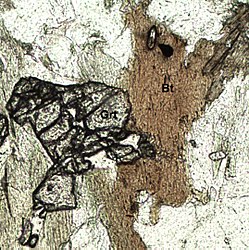Optical relief
Optical relief (usually noted as simply relief) is a concept in optical mineralogy which refers to the degree in which mineral grains stand out from the mounting medium,[1] usually either oil with a known refractive index or Canada Balsam. Relief is an important part of the Becke line test.
Magnitude[]
Minerals that stand out significantly (have a difference in refractive index of .12 or more) have high or strong relief, and will have very sharp boundaries between itself and the material it is next to. Intermediate is .04 to .12, and low or weak is less than .04. Low relief materials have boundaries that are hard to distinguish from each other.

Thin section under plane-polarized light with the high relief mineral clinopyroxene in the center surrounded by the low relief mineral plagioclase feldspar.
Polarity[]
Relief is said to positive when the refractive index of the mineral is higher than the refractive index of the medium, and negative when the opposite occurs. In regular observations only the magnitude of relief can be seen (minerals with positive and negative relief will look the same) and other techniques (such as the Becke Line Method) must be employed in order to determine if a mineral has positive or negative relief.
References[]
- ^ Nesse, W. D., 1991, Introduction of Optical Mineralogy, 2nd edition, p. 25.
- Nesse, W. D., 1991, Introduction of Optical Mineralogy, 2nd edition.
- Optical mineralogy
- Petrology stubs

